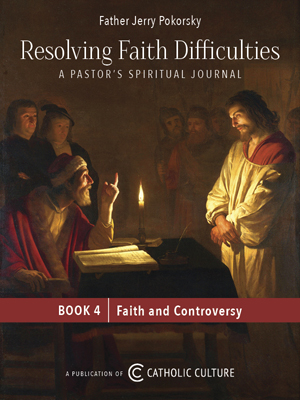Learn to Love Mary, Our Heavenly Mother
Dear Friends,
1. I am always delighted to return to the Roman Seminary, built in the shadow of the cathedral of Rome. I come with deeper emotion during this Jubilee Year which brings us into the third millennium. I greet you all, the Rector, teachers, seminarians, young people and friends. Thank you for your cordial welcome!
I extend a special greeting to the Cardinal Vicar and to the Episcopal Board, the parish priests and the diocesan and parish co-workers, who collaborate with the seminary in a generous effort to give new life to the pastoral care of vocations.
2. Together we have contemplated the beginning of salvation history in the joyful mysteries of the Rosary. Mary, St Bernard reminds us, "believes, trusts and accepts" (Homily, IV, 8). Through her example and intercession, we too learn to believe, to trust and to receive the abundant gifts of grace which the Lord wants to lavish upon us. In the history of individuals and peoples, it is Mary who discloses God's pedagogy to our communities and to the whole Church. She makes us responsive to faith, trust, and humble acceptance.
Dear seminarians, love Mary, our heavenly Mother, during the years of your formation and those of your generous and holy ministry, so that one day you may honour her in heaven. Taking part in today's celebration of Our Lady of Trust are all the friends of the seminary and especially the young people who are walking with you and who look to you, because they too want to know the secret of your life. May your example help many young people overcome the thousand fears of life and to open themselves to trust and commitment. Today, in a certain way, is a celebration for the entire diocesan community, particularly for those parishes and pastoral situations where you work and where your "yes" to the Lord is tested and strengthened.
3. In the Holy Rosary we have seen Mary listening to God and opening herself to conversation with him. In her interior attitude we see our model of prayer. She teaches us that to pray we must enter our own room and, after closing the door, speak to the Father in secret. Mary knows well that only the Father's eyes see in secret and cross the threshold of every human heart (cf. Mt 6:5-6). She knows well that only an intimate encounter with the heavenly Father communicates that fire of love which spurs us to come out of our room and follow Christ's call. Mary is a model of wisdom and faith. In waiting, she does not take her eyes off the Bridegroom who comes; indeed, she wisely provides oil for the lamp of faith in the night of fear, in order to cross the threshold of nuptial joy (cf. Mt 25:1-13).
Dear young seminarians, learn from Our Lady of Trust how to become trusting and vigilant servants of the Gospel as you await the Lord's coming in glory. May Mary teach you to grow in your vocation and to form the heart of her Son within you. May her example prompt you to transform your lives into generosity to the poor (cf. 1 Jn 3:17) and into availability to the guests who arrive at inconvenient times (cf. Lk 11:5-8). Accompanied by her, you too will experience the joyful confidence of the Apostles who, in obeying God rather than men, discovered how the Word of God overcomes the locked doors of every prison (cf. Acts 5:17-25) or any form of discrimination.
4. Salve radix, salve porta, ex qua mundo lux est orta!
Dear friends, throughout the Holy Year let us continue to entrust our future commitments to Mary. May Our Lady of Trust guide the seminary and accompany the diocesan community to experience the Living One, who vanquishes fear and gives peace (cf. Jn 20:19). May she help you to imitate the Good Samaritan, who pours oil and wine over the wounds of those who live in Rome or who come to Rome from every part of the world (cf. Lk 10:29-36). May Mary teach gladness of spirit to every young man who crosses the threshold of the seminary.
May the olive tree which I have just blessed in the portico be for the seminary the sign of service to vocations. Jesus Christ is the centre of every vocation. He is the Teacher in whose shadow you will pause to listen: he is the suffering Servant who takes you with him into Gethsemane when men abandon you. Jesus is the root and the tree on which we are grafted like olive branches made fruitful by the Cross. From the Lord we receive our vocation, like oil scented with new life. May the Father, who anointed his Son Jesus with the oil of gladness (cf. Heb 1:5-14), make the heads of each of you shine with the oil of holiness.
Have a good Holy Year! May the Lord grant many vocations, like olive shoots around the table! I bless you all with great affection.
The Holy Father then spoke extemporaneously to the seminary community:
I would like to thank you all for your hospitality. Visiting the Roman Seminary in the Jubilee Year,I again thought of the one I left so many years ago: the seminary in Kraków.
I thought: in Kraków I could talk to every seminarian; in Rome, I can only extend my hand to each seminarian. But thanks be to God for the Cardinal Vicar of the Diocese of Rome! To him I leave the pleasure of conversing with you. The Cardinal tells me that he has many conversations with you. This is great!
The Holy Year has begun very well. It has exceeded expectations. This is what we have seen in the first days, the first weeks, the first two months.
I also hope that you, seminarians of Rome's Major Seminary, can make the most of this year of grace, and with faith pass through the Holy Door of St Peter's, which leads us symbolically to salvation.
So, have a good Jubilee Year, a good Holy Year, a good year 2000, a good academic year and a good year at the seminary!
© L'Osservatore Romano, Editorial and Management Offices, Via del Pellegrino, 00120, Vatican City, Europe, Telephone 39/6/698.99.390.
This item 2641 digitally provided courtesy of CatholicCulture.org






